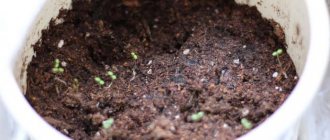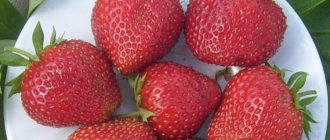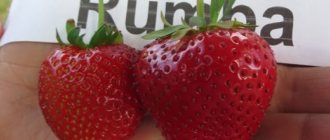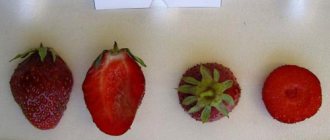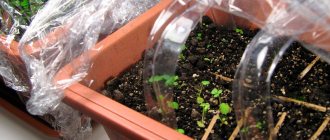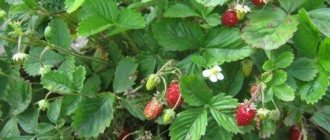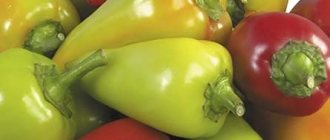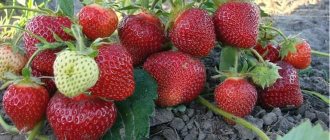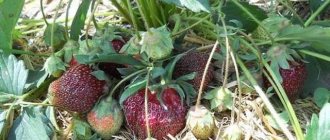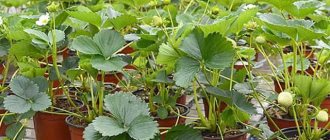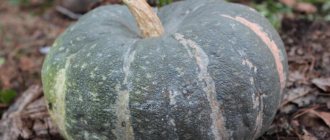Loading…
Loading…
Among the many types of berries, the most popular is the Ali Baba strawberry, a description of the variety, photos of which are presented below. This plant is in particular demand among summer residents. It gained its popularity not only due to its good taste, but also because it is easy to grow.
Description and characteristics of the variety
A new type of strawberry was bred in 1995 by Dutch breeders. Scientists Hem Zaden and Yvon de Cupidou from the agronomic company Hem Genetics created Ali Baba from wild strawberries. As a result, we obtained a strawberry variety that has many positive properties.
- The variety can be grown in almost all regions of Russia.
- Suitable for cultivation in open ground, in greenhouses, greenhouses and even on the balcony. The plant is planted in pots or small trays to decorate loggias, front gardens, and borders.
- Ali Baba strawberry is a remontant variety.
- Fruits from June to mid-autumn.
- The bush has a strong, spreading stem and can reach a height of 16-18 cm.
- The leaves are dark green. The plant produces many white inflorescences even in the first year.
- The most striking feature of the Ali Baba variety is that the bushes do not form a mustache.
- High yield. During the season, you can collect up to 0.4-0.5 kg of tasty fruits from 1 bush. From 10 bushes, 0.3 kg of strawberries are harvested every 3-4 days.
Advice! To ensure a richer fruit harvest during late harvests, it is recommended to break off the peduncles of the first wave. In this case, the plant will become especially strong and developed, and the next waves of fruiting will be abundant.
- An unpretentious variety that tolerates drought and cold well. It is also unpretentious to various types of soil. Ali Baba strawberries are successfully grown in continental climates, in central Russia, the Moscow region and other regions.
Pest and disease control
Strawberries are resistant to many diseases and insects. But with excessive exposure to unfavorable conditions, plants are susceptible to diseases.
Control and prevention measures (Table 3):
| Diseases/pests | External features | Control/prevention measures |
| Strawberry mite | Appears on young foliage, leading to yellowing and death of leaves. | · Seedlings are immersed in water (47°C) for 20 minutes. Wash with water. · Spraying with karbofos - 3 tablespoons per 10 liters of water. · Crop rotation. · Trimming of green mass. · Spraying with a solution of colloidal sulfur – 50 g per bucket of water (spring, flowering, fruiting). · Timely weeding. · Bitoxibacillin – 35–75 g per 10 liters of water. |
| Slugs | Harmful to green mass and fruits. | · Mechanical removal of the pest. · Treatment with infusion of fragrant herbs. |
| Spotting | Rotting, spotting | · Fitosporin – 15 ml (per 10 l). · Zircon – 2 drops. Fitoverma – 5 drops. |
| Gray rot | Rotting fruits. | · 1% solution of Bordeaux mixture |
Berries can be collected 14 days after treatment. Planting marigolds, dill, and garlic near strawberry bushes helps repel pests.
Photo
Below are photos of the strawberry variety Ali Baba .
Advantages and disadvantages
Experienced gardeners who already grow Ali Baba strawberries on their plots can note some of its features.
Advantages:
- The variety brings large yields.
- Fruits constantly until frost.
- Delicious berries with a strawberry aroma have universal uses.
- Withstands moisture deficiency and first frosts.
- It is resistant to various fungal diseases and is almost not affected by harmful insects.
- Strawberries bear fruit in the first year after planting in the ground.
- Many gardeners grow this variety of strawberries as an ornamental plant in a pot.
- Unpretentious to the composition of the soil. Can grow in any climate conditions.
Flaws:
- Collected fruits cannot be stored for a long time. After harvesting, the berries are immediately processed or consumed fresh.
- The fruits do not tolerate transportation well.
- The variety does not form mustache, so it is propagated by seeds or by dividing the bush.
- It is recommended to rejuvenate the plot with strawberries every 2-3 years. Otherwise, fruit quality and yield will decrease significantly.
Landing
Since strawberries produce their first harvest in the year of planting, having planted them in the spring, you can very soon enjoy the first berries. But before you plant a plant, you need to choose a site for it. Strawberries do not tolerate excessive moisture; you need to take this fact into account in advance.
Crop rotation
It is not recommended to grow strawberries after the nightshade family. The best preceding crops for it will be:
- Beet.
- Carrot.
- Plants of the legume family.
Features of cultivation
Despite the fact that the Ali Baba variety is simple and unpretentious to grow, it is necessary to take into account some nuances.
Lighting
Just like wild strawberries, this variety feels best in partial shade. If the plant is planted in an area that is illuminated by bright sun, this may affect the quality of the berries: they will be hard and not juicy. In a heavily shaded area, the yield will be small.
The soil
Strawberries grow best on non-acidic and loose soil that allows air to pass through well. In addition, she loves fertile soil. Before planting seedlings in open ground, they need to be sprinkled with lime or ash.
Advice! It is not recommended to grow this crop in low, marshy areas, as the bushes can be affected by fungal diseases.
Before choosing a site for sowing strawberries, it is important to consider such a fact as crop rotation. The plant takes root well and develops in the place where its predecessors were onions, beets, carrots and garlic. After nightshade and cruciferous crops, the plant grows difficult.
Terms and rules of sowing
The strawberry variety Ali Baba is propagated only by seeds or by dividing the bush. Strawberry seeds are sown already in February, but 14-20 days before they begin to be prepared for sowing.
Seed selection and preparation
First of all, you need to take a responsible approach to purchasing seeds, since if you choose the wrong ones, they will produce poor seedlings or the plants will be weak.
You can buy strawberry seeds in a special store. Seed material is cheaper on the market, but there is no guarantee that it is of high quality. You can collect the seeds of this variety yourself. Moreover, it will be possible to collect more of them. From the entire mass of grown seedlings, you can select the healthiest and strongest specimens for planting.
A characteristic feature when growing strawberry seedlings from seeds is that they do not sprout at the same time: the time difference can be 20-30 days. In order for the seeds to sprout well, a stratification procedure should be carried out. It can be done in several ways.
- Place the seeds on a natural fabric moistened with settled or melt water. Keep it in a warm place for 6 hours. After this, wrap it in plastic and place it on the bottom shelf of the refrigerator for 3 days. The seeds are ready for planting in the soil mixture.
- For better seed germination, they are treated with growth stimulants: Epin, Zircon, Potassium Humate.
- Snow is placed on top of the prepared tray with the substrate and lightly compacted. Place strawberry seeds on it using a toothpick. Then the container is covered with a transparent film and placed on the windowsill. When the snow begins to melt, moisture will draw the seeds into the soil. In the warmth, they will quickly begin to germinate.
Planting strawberries
The Ali Baba variety, like many other plants, prefers nutritious and loose soil. The safest thing to do is to buy a ready-made mixture, which is sold at any garden store. An excellent option for growing seedlings is in peat tablets. But, you can prepare the desired composition yourself using some recipes:
- Mix peat, coarse sand, and humus in a ratio of 3:1:1.
- We combine turf soil, neutral peat, coarse river sand in a ratio of 2:1:1.
- Chernozem, peat, sand in a ratio of 2:2:1.
The prepared soil mixture is laid out in a tray with a layer of 5 cm. Shallow grooves are made along the entire length of the area. A distance of 2 cm is left between them. The area is carefully moistened with a spray bottle.
Seeds, which are not covered with soil, are placed in the furrows and sprinkled with water again. The trays are covered with a transparent lid or polyethylene and left in a bright place. It is important to constantly monitor soil moisture. When the seedlings have 2 strong leaves, they are planted in separate containers. Seedlings are planted in a permanent place after 5-6 leaves appear.
You may be interested in: Planting strawberries with seeds for seedlings: how to choose seeds, soil, seed sowing technique and features of caring for seedlings
Useful information: Garden strawberries: growing from seeds with seedlings in open ground. Secrets of reproduction and care
Top dressing
To get a strong plant that will produce high yields of berries, it is necessary to feed it with special means. Typically, gardeners use the following recipe for preparing mineral fertilizer:
- 2 tbsp. spoons of nitrophoska;
- diluted in 10 liters of water.
Important! The nutrient solution is injected under the root. If it gets on the leaves, it can damage the plant.
Planting in open ground
Strawberry seedlings are planted on the plot in rows, between which the distance should be about 30 cm.
The bushes are placed at a distance of 20 cm from each other. First, the plant is covered with plastic wrap.
How the strawberry variety Ali Baba propagates
The main methods of propagating strawberries of this variety are dividing the bush and growing from seeds. The method of propagation with a mustache, which is very convenient for gardeners, is unacceptable, since Ali Baba does not form a mustache.
Growing Ali Baba strawberries from seeds
Propagating strawberries or strawberries from seeds is quite troublesome. This method is often used by experienced gardeners who have knowledge of agricultural technology for growing in this way and their inherent patience.
Sowing is scheduled for the end of January or beginning of February. If it is not possible to properly illuminate Ali Baba’s seedlings, then the deadline is postponed to March.
Containers for seedlings can be boxes, containers or cups. Many gardeners prefer sowing in peat tablets.
Seeds must be prepared before sowing. For quality preparation you need:
- Soak the planting material for several days in water. For these purposes, it is good to use melt or rain water. Thus, germination increases and substances that suppress the development processes - inhibitors - are destroyed.
- Place a layer of dampened strawberry seeds on thin paper to dry.
- After absorbing moisture, place the still slightly damp seeds in a plastic bag and wait until they hatch.
- Plant the sprouted seeds of Ali Baba.
The second method of preparation is called stratification. It involves keeping Ali Baba seeds in a cool room for a month. A regular kitchen refrigerator will do. Then the planting material is moved to a warm room with a temperature of + 20 ° C and germination is waited for.
The soil mixture should be prepared from humus and sand (5:3), placed in a container, and moistened. Distribute Ali Baba seeds on top, then sprinkle with soil in a very thin layer.
Important! The first layer in containers should be drainage (1/2 volume). Cover the container with glass
Raise it periodically and moisten the soil as the soil dries out.
Cover the container with glass. Raise it periodically and moisten the soil as the soil dries out.
A month later the first sprouts appear, and after 14 days the strawberry seedlings are ready for picking. Maintain a distance between plants of the variety of at least 2 cm, but no more than 4 cm. The strawberries of the Ali Baba variety are picked for the second time in the phase of 4-5 leaves, and when 6 leaves develop, they are ready for planting in open ground.
Important! Strawberry seedlings begin to be hardened from the moment of sowing, and 2 weeks before planting they are taken out into the air
How to propagate Ali Baba garden strawberries by dividing the bush
Since propagation by mustache is unacceptable for the Ali Baba variety, the second method is to divide the bush.
The most prolific and largest bushes will do. You can start dividing only after harvesting. The procedure is quite simple:
- Dig up the selected strawberry bush.
- Divide into parts, each of which has a heart with 3 leaves.
Important! Each division must have at least 2-3 white roots; dark brown roots are not suitable. Many gardeners prefer to divide Ali Baba bushes in the spring so that they can reap the first harvest the following year.
Many gardeners prefer to divide Ali Baba bushes in the spring so that they can reap the first harvest the following year.
Trim the roots of the variety to 8 cm and plant it in a prepared bed. Be sure to trim the leaves.
